What is the use of laboratory scale spray dryer?
Spray drying is a process in which the material to be dried is atomized into extremely small droplets by an atomizer, and sufficient heat and mass exchange is carried out with the hot air as a heat source to remove moisture and dry. It is an ideal drying method for processing solutions, suspensions, emulsions and other materials. Spray dryers are divided into two categories according to their applications, one is laboratory spray dryers and the other is industrial spray dryers. Today we will introduce the application, model and characteristics of laboratory spray dryer price in detail.
1) Application scenarios and cases of laboratory spray drying.
The characteristics of the laboratory spray dryer are small size, not easy to block, beautiful appearance and precise control. The outer wall of the glass bottle makes it convenient for the experimenter to study the drying process, and the corresponding problems can be adjusted in time. Antistatic treatment can prevent dry powder from sticking to the wall. Due to the limited space in the laboratory, high precision requirements, and not too much drying, laboratory spray dryers are the best choice for laboratories at present. Today we will introduce the application of the experimental spray dryer.
The temperature control of the laboratory spray dryer adopts real-time regulation PID constant temperature control technology, and the temperature control is accurate. Spray dryers are widely used in various fields and can be used in the chemical industry: such as battery raw materials, alkaline dyes, compound fertilizers, formaldehyde silicic acid, catalysts, amino acids, silica, etc. The laboratory spray dryer can also be used for plastic resins: ABS emulsion, urethane resin, phenolic resin, polyethylene, polyvinyl chloride, etc. It can also be used in the food industry, such as milk powder, cocoa milk powder, milk replacer powder, egg white (yellow) whole egg powder, etc. Can be used in food and plants, such as oat, coffee, instant tea, protein, soybean, hydrolyzate, etc. Can be used for sugar, corn steep liquor, glucose, pectin, potassium sorbate, etc. It can be used for drying of ceramic materials, such as ceramic tile materials, magnesium oxide, talc, etc.
Honey Papaya Powder:
When preparing honey papaya powder, an experimental spray dryer was used to dry the material. The process parameters of the spray dryer are the compressed air flow rate of 859 L/h, the feed rate of 15 mL/min, and the inlet air temperature of 166 °C. Such a drying process can ensure that the papaya powder will not stick to the wall when making honey papaya powder, and can ensure the nutritional value of the product.
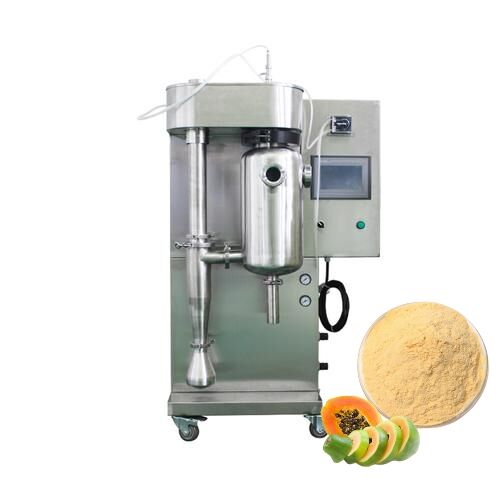
Spent yeast puree for beer:
When drying the waste yeast puree of beer, in order to better protect the superoxide dismutase SOD activity in the waste beer yeast puree, an experimental spray dryer was used for experimental drying. The process parameters are the inlet air volume of 4320 m3/h, the inlet air temperature of 134 °C, and the feed rate of 3.75 mL/min. From the production point of view, spray drying is more energy-saving and environmentally friendly, and has high production efficiency and advantages.
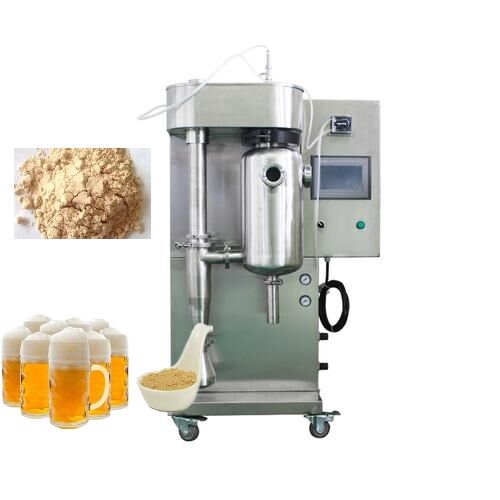
Chinese herbal extracts:
When spray-drying natural product extracts and fruit juices of traditional Chinese medicine (Chinese herbal medicine) in the laboratory, since the material itself contains a lot of sugar components, sugar is relatively easy to melt at high temperature, and it melts at the moment of spray drying, sticking together, forming an image like The brown sugar-like thing stuck to the bottle wall in the drying chamber of the spray dryer. Zhengzhou Keda's laboratory spray dryer is a small vacuum low-temperature spray dryer, which is specially developed for this type of material. It realizes instant drying of the material under the low temperature of the inlet air temperature, and avoids the activity or structure of the material during the drying process. It is destroyed, providing a very convenient and safe drying method for heat-sensitive materials.
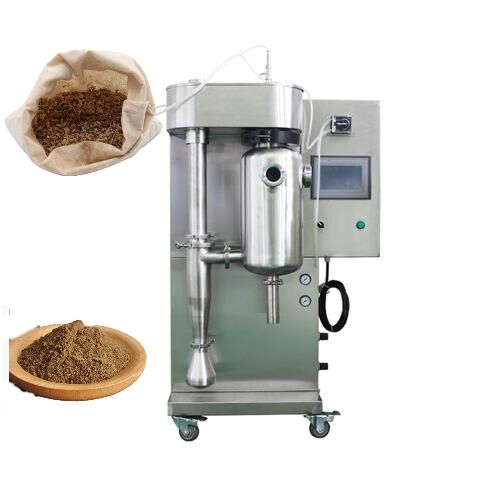
2) Model and parameters of laboratory spray drying.
Zhengzhou Keda laboratory spray dryer is mainly based on SD-2L, laboratory spray dryer technical parameters:
·Inlet air temperature control: ~250℃
·Outlet air temperature control: 30℃~140℃
Evaporation water volume: 1500ml/h ~ 5000ml/h
·Maximum feed amount: (adjustable)
Feeding method: peristaltic pump adjustment
·Minimum feed volume: 80mL
·Temperature control accuracy: ±1℃
·Average drying time: 1.0~1.5S
·Power of the whole machine: 4KW /220V
·Dimensions: 800mm×600mm×1300mm
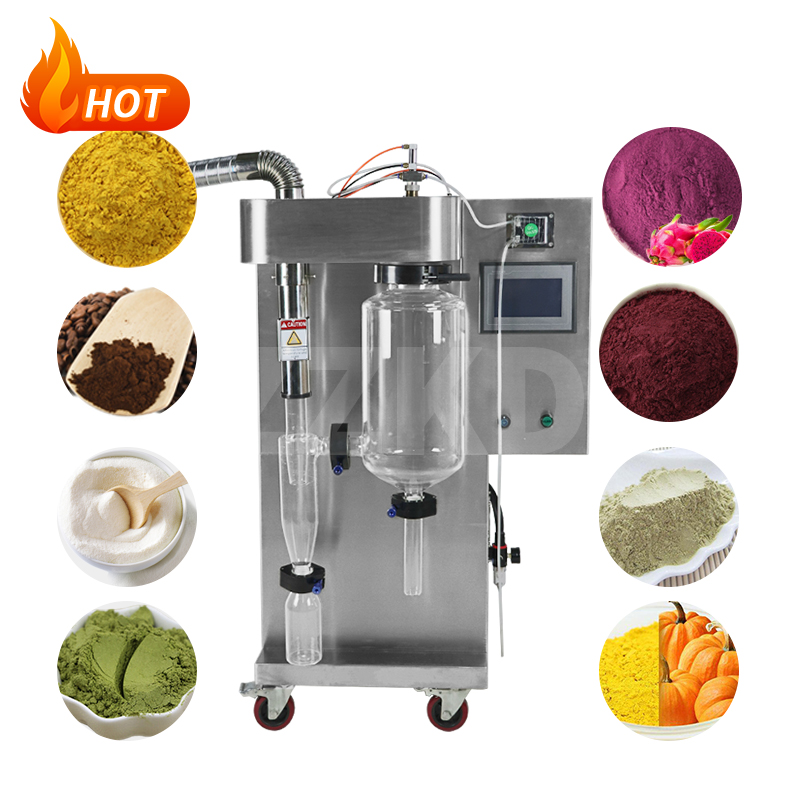
3) Characteristics and selling points of laboratory spray drying.
·The original imported nozzle has high efficiency.
·Fully automatic control: One-button start-up, after setting the spray process parameters, the temperature reaches the predetermined temperature, the peristaltic pump sets it by itself, the operation process is displayed on the touch screen, and the operation process of the spray dryer is clearly displayed.
Manual control: The process parameters can be adjusted at any time during the experiment, and the entire experiment process is displayed on a color touch screen
·The whole system is made of stainless steel, and the drying process is carried out in a non-polluting environment.
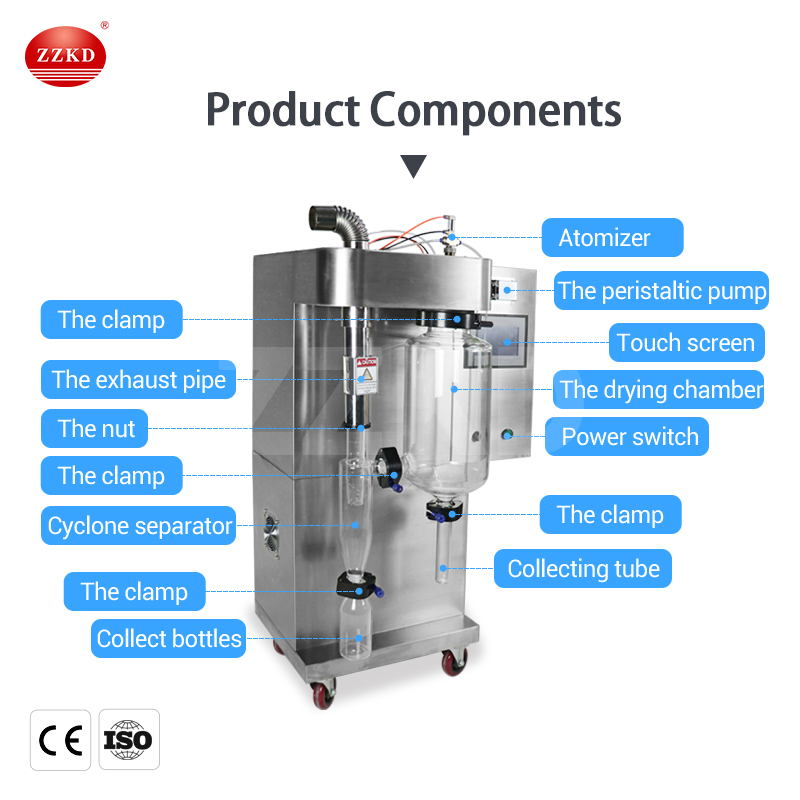
·Imported all oil-free air compressor, the particle size of the powder is normally distributed, the fluidity is very good, and the noise is very low, less than 60db.
·The atomization structure of imported two-fluid spray, the whole machine is made of high-quality stainless steel material, the design is compact, and no auxiliary equipment is required.
·The feeding volume can be adjusted by the feeding peristaltic pump, and the minimum sample volume can reach 50ml.
The particle size of the finished dry powder after drying is relatively uniform, and more than 95% of the dry powder is in the same particle size range.
·For viscous materials, there is a nozzle cleaner, and the frequency of the needle can be adjusted automatically.
·The innovative tower wall air hammer device prevents material accumulation, and the material recovery rate is higher.
The above is the application, characteristics and parameter information of the laboratory spray dryer that we will introduce today. If you are interested in learning more about spray dryers, please contact us.


